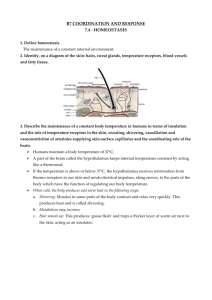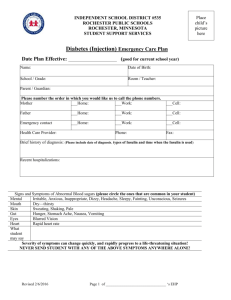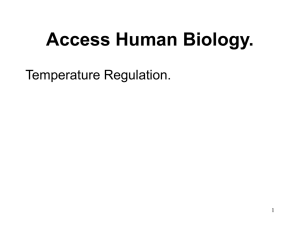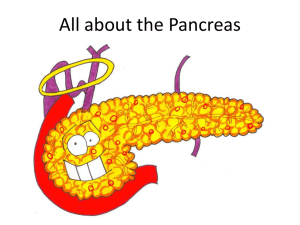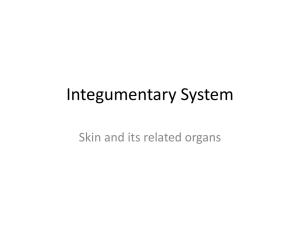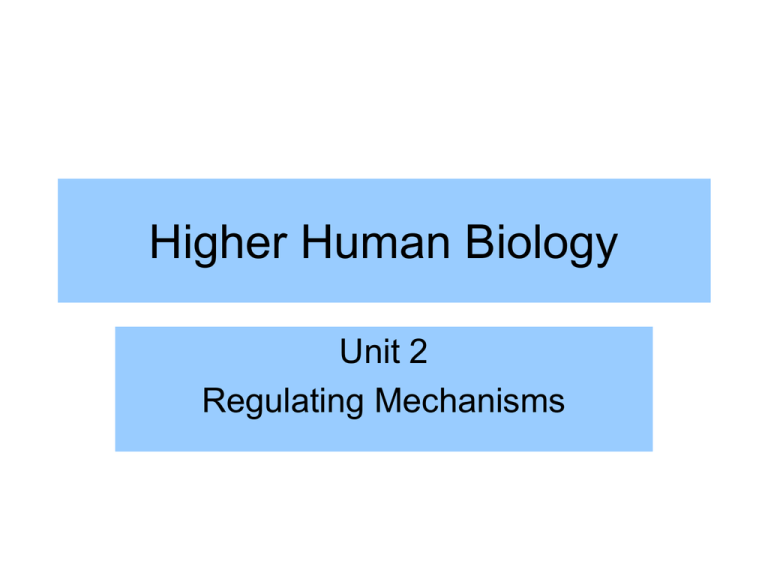
Higher Human Biology
Unit 2
Regulating Mechanisms
Homeostasis
Control of blood sugar
• Insulin and glucagon are two hormones
that control how much glucose (sugar) is
in the blood
• These hormones are made in the
pancreas, a gland that sits just behind the
stomach.
Pancreas
• Your pancreas
contains small groups
of cells called the
islets (or islands) of
Langerhans.
Pancreas
• When you eat a meal, the
amount of sugar in your
blood rises. The cells in
your pancreas react by
making more insulin.
• When your blood sugar
levels are low, the cells in
your pancreas react by
making more glucagon.
What does insulin do?
• After digestion, glucose enters your bloodstream.
• The Islets of Langerhans in the pancreas detects an
increase in blood sugar level.
• These cells produce the hormone insulin, which is then
transported to the liver in the bloodstream.
• Insulin activates an enzyme to catalyse the reaction
glucose
glycogen
• This decreases the blood sugar level.
• Glycogen, a long chain carbohydrate, is stored in the
liver until it is needed e.g. when you are sleeping
What does glucagon do?
• Glucagon stops your blood glucose level from
dropping too low.
• When you exercise, your body uses the glucose in your
blood to power your muscles. Your pancreas senses that
you're using up your glucose supply.
• As your blood glucose level drops, your pancreas stops
making insulin and your pancreas makes glucagon
• Glucagon activates an enzyme in your liver which
catalyses the following reaction
Glycogen
Glucose
• These activities push up the amount of glucose in your
blood.
Control of blood sugar
Control of Body Temperature
• Core body
temperature must
remain at 37oC
• Careful control of the
blood supply to the
skin can do this by
reducing blood flow to
the colder extremities
in cool conditions
Heat Stress
• The sympathetic nervous system directs the
body’s attempts to regulate temperature by rerouting circulation and sweating
• Red skin indicates vasodilation and the
collecting of blood near the surface for release
of heat
• Sweating causes evaporative cooling
• The individual reduces heat stress by lowering
physical activity levels, scheduling work during
cool times of the day, wearing less clothes, using
fans and air conditioning
Forms of heat loss
Temperature control system
Position of the Hypothalamus
Sweat glands
• Sweat glands
dampen the skin.
This loses heat by
causing evaporation
of the sweat
Sweating under pressure!
Sweating caused by heat
Sweating caused by muscular
contraction
Nine Sweaty Facts
•
•
•
•
•
•
•
•
•
Humans are the most prolific sweaters in the entire animal kingdom
Sweating is accomplished through specialized sweat glands
These glands are found in the dermis and epidermis, distributed all over the
body, except for the margins of the limbs, sex organs, and ear drums
They average between 150 and 340 glands/cm2 of skin for a total of
between 2,000,000 and 5,000,000
Add them all together and you get a hole the size of your mouth
The sweat glands are innervated by the sympathetic nervous system
When a rise in core temperature is detected by the hypothalamus, impulses
to the sympathetic system cause an increase in sweat output
The sweat gland consists of a deep coiled portion and a duct that opens on
the skin
The duct aids in the re-absorption of electrolytes, mainly sodium and
chloride, in the sweat so that the fluid discharged onto the skin has had the
electrolyte concentration reduced by a factor of about 20
Non-sweaty
ways of cooling
down may still
use the
evaporation of
water
Heat Transfer by Circulation
• The peripheral (surface) circulation relies on
beds of capillaries that transfer blood between
the arterial and venous systems
• These changes in circulation can change the rate
of blood flow from internal organs to the
periphery by as much as 30%
• Vasoconstriction (reducing the diameter of the
capillaries) reduces the blood flow from the core
to the periphery. This reduces heat loss.
• Vasodilation (increasing the diameter) increases
the flow of blood under the skin. This increases
heat loss by radiation
Surface
capillary
artery
vein
Cold Stress
• The body attempts to increase and conserve
body heat by rerouting circulation, raising hairs
to trap more insulating air, and shivering
• Vasoconstriction causes the blood to pool
internally to conserve organ heat
• Shivering causes the temperature to increase
due to muscular activity
• Individuals respond to cold stress by increasing
muscular activity, wearing more clothes, or
heating their living space
In cold
conditions
heat is made
by shivering.
This extra
series of
muscle
contractions
causes a rise
in body
temperature
Surface
of skin
hair
Hair muscle
Contraction of
this muscle
makes the hair
stand on end,
trapping more
insulating air.
Coping with heat and cold
• Factors Affecting Thermal Acclimation
Age
• Both infants and elderly have lessened ability to
acclimatize to heat or cold
Body size and shape
• The surface area to weight ratio will affect the
level of acclimatization attainable
Body composition
• Subcutaneous adipose deposits (fat) insulate
the core and make it more difficult to dissipate
heat in hot or easier to retain heat in the cold


